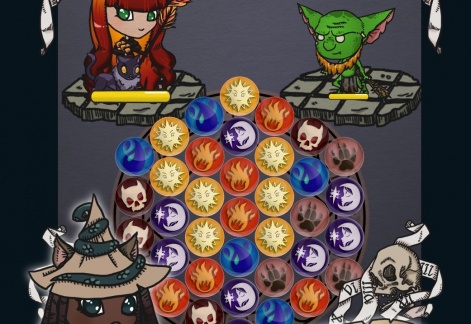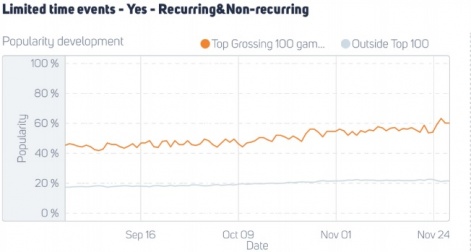Last week, we began out latest Mobile Games University course on Monetisation Design, looking into the different types, the design process and psychology behind it.
Unity Evangelist Oscar Clark also shared his expert advice with the seven rules of monetisation design.
And on Wednesday December 7th, he'll be presenting a free webinar on the subject.
But what do other mobile game developers think is the key to bringing your monetisation to the next level? To find out, we asked our Mobile Mavens the following:
- What do you think is the single most important rule of monetisation design?
- What are some of the best monetisation mechanics you've seen this year?
If I have to pick only one thing that separates top earners from the rest of the games on the App Store, I will have to go with plain, enormous volume.
The in-game economies of the top games are just huge - worth tens of thousands of dollars or more.
Meanwhile, most indie games' economies top out at a few tens of dollars. There's about a 1000x difference there.
(I believe that I also listed this as #1 in my PGC Helsinki talk this summer.)
As for the monetisation of the year, I'm very impressed with how Rovio managed to improve Angry Birds 2 during the year.

Adam has been in the mobile game industry since 2007, creating games independently. He's since grown into a full 50+ person studio manager.
Recently he's taken a position at Wooga in Berlin to sharpen his design skills and work with the world's best to create amazing, well-crafted products onto the mobile marketplace.
Completely agree. The base of all strong monetisation is scale - essentially pacing multiplied by content.
The base of all strong monetisation is scale.Adam Telfer
Economies must last tens of thousands of dollars.
Dimitar Draganov at GDC Europe 2015 showed how Game of War's economy was built to last beyond hundreds of thousands of dollars - and that was ignoring social purchases.
As for monetisation mechanics this year, Pokemon GO's lure mechanic was excellent for a very approachable, social purchase.
You felt great about purchasing it since benefited everyone around you.
Usually these types of social purchases don't become enticing until you've joined a guild - and usually that's in the late game. Pokemon GO had a great way of implementing this mechanic early in the lifetime of its players.

Founder and CEO of Chorus Worldwide, a publisher for Western mobile developers seeking success in the Asian markets, Shintaro has over 20 years' experience within the gaming industry.
He has worked in various roles from game production, localisation, marketing and business development at companies such as EA, SCEE, Rare and Microsoft.
There’s this great system I saw whereby a player learns about a game, pays all the money the developer/publisher wants for it upfront, and then the player gets to play the whole game without any pull to spend any more money.
It’s pretty radical, but it has profound implications for game design. Might just be the next big thing.
In all seriousness, we’re going to be publishing a game in the new year called Glyph Quest Chronicles from We Heart Dragons, an indie team in Brighton.
The game is going to try square the circle of:
- Being free-to-play;
- Allowing players to have an experience as unencumbered as possible of continual monetisation;
- And being profitable.
It’s an experiment, but we’re putting in something called Patron Mode, which rewards players that have spent a certain amount of money on the game to enjoy the rest of it without as much of a need to spend more money.
Common wisdom - which may well be right - says that removing the incentive to pay from people that have already proven themselves to be good spenders is incredibly dumb.

But the philosophy behind it is that the team feels the game is “worth” a certain amount, and after that, they should be able to play unencumbered (they will still be able to enjoy the shortcut items), but the Patron Mode experience will have less pay-friction than the non-Patron Mode version.
While we will be reducing the maximum amount that we could potentially monetize a “whale” for, the experiment is to see if it encourages non-payers to take the plunge to becoming a patron.
Time will tell if this was complete folly...
For me, content volume is important to allow high levels of spend, but it doesn’t create it.
Players are only so motivated by game mechanics, however they’re highly motivated by other people. So giving players ways to interact (constructively or destructively) is the most important element of monetisation (or indeed retention).
Effective F2P design puts compelling human interaction as the central focus.
The main thing of import is to have a free-to-play design that players themselves view as fair and reasonable. Players shouldn’t have to 'pay to win'.
91% of the top 100 games in the US app store feature an energy mechanicWilliam D. Volk
What seems to work best is a system that will allow most players to play for free if they limit the amount they play per day (or other time period).
The currency or energy is expended during gameplay. That is, they run out of ‘energy’ but they will be rewarded with more energy the next day.
They aren’t forced to buy more to continue to play, but the amount of play is restricted by this. 91% of the top 100 games in the US app store feature this mechanic, according to GameRefinery.
This so-called “energy mechanic” plays a big role in Candy Crush Saga.
This is a good mechanic because it encourages retention; the players come back to get more energy.
The players who want to play more, right then and there, then will spend money on the energy to do so.
Of course DLC plays a role as well, but I’d say a well designed energy mechanic seems to be a common thread in the success of free-to-play games.
GameRefinery has lots of data on this, as William pointed out. They kindly gave me permission to tell about the current top three.
These are the ones where we see the largest difference between top 100 grossing games, and the rest:
- Sending/asking for help
- Limited time events
- Limited time IAP offers.
The first is, obviously, a social feature as Will already explained. The other two are really parts of live ops.

The session length restrictions that William linked to are also still popular, with 95% using them in the Top 100, and 65% of games outside the top 100.
I did a longer dig through the GameRefinery data earlier this year here.
Monetisation design often ends up at odds with game design in the sense that creatives often tend to think there's an inverse correlation between aggressive monetisation and fun gameplay.
However, I would say that the best games tend to marry fun factor and monetisation design in a way that enables outsized levels of spend and addiction by design.
In my experience, working on top grossing titles at both Kabam and now at EA, I would say the single most important "rule" of monetisation design is to create situations in-game that enable 'impulse purchase' behaviour.
The single most important rule of monetisation design is to enable 'impulse purchase' behaviour.Devin Nambiar
These situations create a chaotic environment where a player is forced to make a decision that directly impacts the result of something in the game, and this decision is time boxed.
The best example of this are, as someone previously mentioned, limited time mechanics. This includes limited time events, but also limited time boosts and limited time offers.
When you force a player to make a decision within a finite time window, you'll create a sense of urgency that compels spend to achieve the desired result.
One simple but great example of this is actually in Netmarble's Seven Knights, a Korean battle card game on Kakao that offers limited-time discounts on gacha pulls upon a user not getting the chase prize when pulling the gacha.
This is done through emergent UI within the gacha itself, in a way that offers the player a discount if they want to 'give it another go' - but only if they pull the gacha again right now.
I thought this was a great and elegant tactic that would lead to increased indexed gacha pulls per player, and hence direct sinking of hard currency, which is what monetisation is all about in F2P.

























